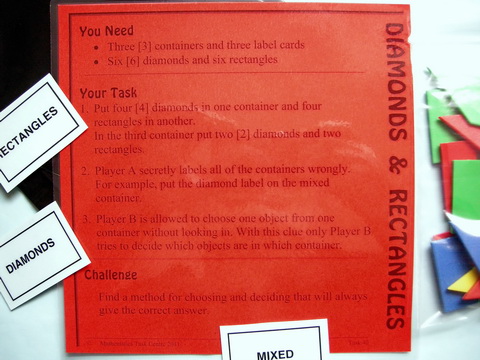
Diamonds & RectanglesTask 40 ... Years 4 - 10SummaryShapes are sorted into categories, then placed in bags which are all incorrectly labelled. Is it possible to make one selection from one bag and be able to work out what is in all the bags? That's the challenge, and once solved the next challenge is to be able to explain your reasoning to someone else. |
Materials
Content
|

IcebergA task is the tip of a learning iceberg. There is always more to a task than is recorded on the card. |
There is another problem lurking here which would be better explored using the same shape (or object) in two colours, such as the counting bears suggested for the class lesson below. Put all 12 shapes in a bag. Select two at random. What is the chance your selection will be a pair? What happens if you change the mix in the bag?(This problem is a bit difficult to address satisfactorily with the equipment in the task because the students can feel the sharper points of the 'diamonds'.) |
Whole Class InvestigationTasks are an invitation for two students to work like a mathematician. Tasks can also be modified to become whole class investigations which model how a mathematician works. |
Of course it is not necessary to use diamonds and rectangles for this task. Any objects or shapes will do as long as they can't be seen inside the container. You might have toy farm animals (6 sheep and 6 horses for example) or counting bears or cubes in two colours (Red Bear Bag, Blue Bear Bag, Mixed Bear Bag). Containers might be margarine containers. If you do want to use shapes then use a computer to design them, print them on card, and laminate so you have a permanent set. The focus of a whole class investigation would be:
At this stage Diamonds & Rectangles does not have a matching lesson on Maths300. |
Is it in Maths With Attitude?Maths With Attitude is a set of hands-on learning kits available from Years 3-10 which structure the use of tasks and whole class investigations into a week by week planner. |
The Diamonds & Rectangles task is an integral part of:
|